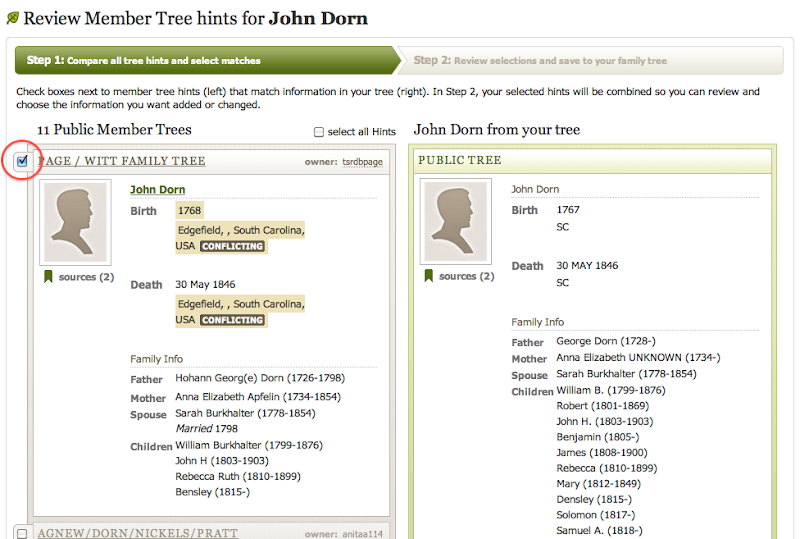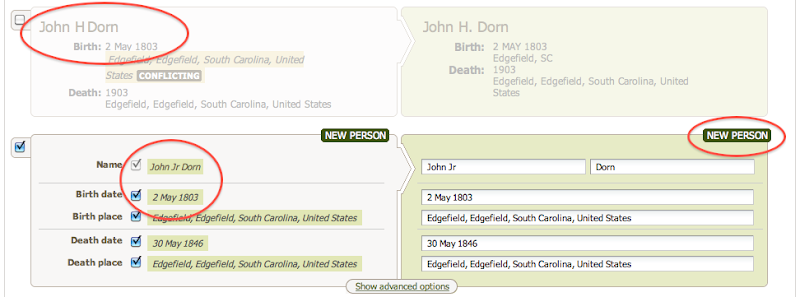I've written before about the successes I've had with Ancestry.com's trees and finding photos. I also find that the online trees are a great way to find new sources for my ancestors. Many online trees might contain errors but might also contain links to documents on ancestry or uploaded photos and documents. By using the "shaky leaf" hints, researchers can easily add these items to their own family tree. At the same time, the prior complaints remain the same. Researchers should always use caution before adding any information to their trees, no matter how easy Ancestry.com had made it. There are ways to utilize the information and Ancestry's system without compromising the caliber of your own tree. Here's how I do it:
 It all starts with the well advertised "shaking leaf." Although I've criticized the simplicity and, as I see it, misleading aspects, of this system, the leaves are still a good place to start. So, I click on the "Family Trees (1)" link, which will take me to my hints page. I will have to click on "Review Hints" for the families trees again to see the trees that Ancestry.com thinks match my own.
It all starts with the well advertised "shaking leaf." Although I've criticized the simplicity and, as I see it, misleading aspects, of this system, the leaves are still a good place to start. So, I click on the "Family Trees (1)" link, which will take me to my hints page. I will have to click on "Review Hints" for the families trees again to see the trees that Ancestry.com thinks match my own.On this page, you'll see the individual from your tree on the right, with each suggested tree on the left. You can review each suggestion to decide if the individual matches your ancestor. If they do, click the checkbox next to the suggestion. This step doesn't change your tree, so don't worry about any "conflicting" highlights that you see. Once you have chosen all the suggestions that match your ancestor, click the orange button to "review selected tree hints."

On this next page, you'll see a page where all of the information from those other trees has been combined and now wants to connect to your tree. Here's what it looks like:

There's a lot going on in the image above. The most important think to look out for if you want to protect the information in your tree is any information marked "NEW." This only happens when the suggested tree has fields filled in that your tree has empty. This information will automatically be checked and will be added to your tree if you don't do anything. See Sarah Burkhalter for example. With these boxes check, marriage information has been inserted into my tree on the right. However, if you look above Sarah to George and Ann, you can see that I have unchecked the "NEW" information and the field on my tree remain blank. The first thing that I do when looking at this page is to uncheck all "NEW" boxes. I don't want to blindly add this information to my tree. Where did it come from? What are the sources? I have no idea. You can also see that a number of fields are marked "CONFLICTING." Because I already have information in these fields, I would have to manually mark the boxes to have this changed in my tree.
As I continue down the list of family members, I find a listing for two different Johns:

According to Ancestry.com's system, these are two different sons named John. One is already listed in my tree, while another is not and is marked "NEW." If I selected on the 2nd John's check box, he will be added to my tree as a brand new entry. But I have to be careful here, because these two John's are the same person. The have the same birthday and everything, but for some reason Ancestry wants to keep them separate. I never add new people from this view.
So if I'm not adding information from these trees, what's the point of making these connections? Like I said before, I find this system to be a good way to find new sources, document and photos for my family. After connecting these trees to my own, I have gained five new hints for my tree. All of the records on their tree, have now been suggested for my own. Perhaps they've been able to find an elusive 1850 census record that I couldn't find because of a strange spelling. Perhaps they've uploaded a document that they received from a local archive. These records will now be suggested to me - and I haven't even visited their family tree. Again, I cannot take these hints as gospel. I still need to review each hint and decide its validity on my own.
In less than five minutes, Ancestry has helped me collect the records from (in this example) 11 different family trees that reference my ancestors. Instead of having to review each tree individually, I can see their sources all at once. Of course, if these sources prove useful, I should review the tree that it came from, which might contain more information.
Genealogists should utilize all forums of research available to them. If they are cautious, there's a lot of great information to be found.

No comments:
Post a Comment